پدرو فیگاری
پدرو فیگاری (۲۹ ژوئن ۱۸۶۱ تا ۲۴ ژوئیهٔ ۱۹۳۸) یک نقاش، وکیل، نویسنده، و سیاستمدار اروگوئهای بود. با اینکه او نقاشی را در سالهای پایانی عمر خود آغاز کرد، بیشتر به عنوان یکی از نخستین نقاشان مدرن شناخته میشود که در آثارش بر ثبت جلوههای روزمرهٔ زندگی تأکید داشتهاست. او در اکثر آثارش کوشیدهاست تا هویت زادگاه خود را با تصویر کردن آداب و رسومی محلی ثبت کند که در دوران کودکیاش مشاهده کرده بود.
| پدرو فیگاری | |
|---|---|
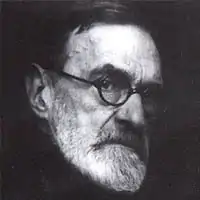 | |
| نام در زمان تولد | پدرو فیگاری سولاری |
| زادهٔ | ۲۹ ژوئن ۱۸۶۱ مونتهویدئو |
| درگذشت | ۲۴ ژوئیه ۱۹۳۸ (در ۷۷ سالگی) مونتهویدئو |
| ملیت | اروگوئهای |
| شناختهشده برای | وکیل، نویسنده، سیاستمدار، مدرس و هنرمند |
| جنبش | امپرسیونیسم آمریکایی |
فیگاری عمدتاً بر اساس حافظهاش نقاشی میکرد؛ شیوهای که اثر را بهمراتب احساسیتر میسازد. او با سبک منحصربهفرد خود که نقاشی بدون قصد ایجاد یک اثر خیالی بود، در کنار سایر هنرمندان مشهور آمریکای لاتین، مانند دیگو ریورا و تارسیلا دو آمارائو، یک انقلاب هویت را در دنیای هنر آمریکای لاتین پایهگذاری کرد.
گالری نقاشی
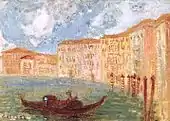 Venecia - ونیز (رنگ روغنی روی مقوا) - ۵۰×۳۵ سانتیمتر
Venecia - ونیز (رنگ روغنی روی مقوا) - ۵۰×۳۵ سانتیمتر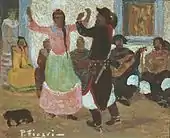 Bailecito - رقص بایلسیتو (رنگ روغنی روی مقوا) - ۴۰×۳۳ سانتیمتر
Bailecito - رقص بایلسیتو (رنگ روغنی روی مقوا) - ۴۰×۳۳ سانتیمتر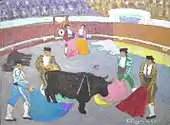 La Muerte - مرگ (رنگ روغنی روی مقوا) - ۸۰×۶۰ سانتیمتر
La Muerte - مرگ (رنگ روغنی روی مقوا) - ۸۰×۶۰ سانتیمتر Flores silvestres - گلهای وحشی (رنگ روغنی روی مقوا) - ۶۸٫۵×۵۳٫۵ سانتیمتر
Flores silvestres - گلهای وحشی (رنگ روغنی روی مقوا) - ۶۸٫۵×۵۳٫۵ سانتیمتر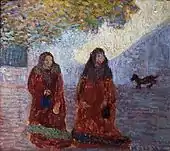 Mirá, Genoveva - نگاه کن: اپرای جنووهوا (رنگ روغنی روی مقوا) - ۳۳٫۵ ×۳۰ سانتیمتر
Mirá, Genoveva - نگاه کن: اپرای جنووهوا (رنگ روغنی روی مقوا) - ۳۳٫۵ ×۳۰ سانتیمتر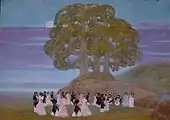 Pericón - پریکون (یک رقص چندنژادی، رنگ روغنی روی مقوا) - ۱۰۰×۷۰ سانتیمتر
Pericón - پریکون (یک رقص چندنژادی، رنگ روغنی روی مقوا) - ۱۰۰×۷۰ سانتیمتر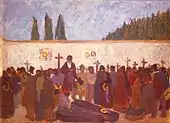 El homenaje - ادای احترام (رنگ روغنی روی مقوا) - ۸۰×۶۰ سانتیمتر
El homenaje - ادای احترام (رنگ روغنی روی مقوا) - ۸۰×۶۰ سانتیمتر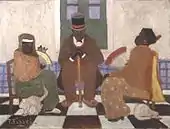 Visita pesada - ملاقات عذابآور (رنگ روغنی روی مقوا) - ۶۳×۴۸ سانتیمتر
Visita pesada - ملاقات عذابآور (رنگ روغنی روی مقوا) - ۶۳×۴۸ سانتیمتر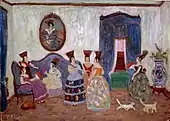 Las siete hermanas - هفت خواهر (رنگ روغنی روی مقوا) - ۷۰×۵۰ سانتیمتر
Las siete hermanas - هفت خواهر (رنگ روغنی روی مقوا) - ۷۰×۵۰ سانتیمتر Mientras la bocha rueda - چرخش کاسه (رنگ روغنی روی مقوا) - ۵۰×۲۶ سانتیمتر
Mientras la bocha rueda - چرخش کاسه (رنگ روغنی روی مقوا) - ۵۰×۲۶ سانتیمتر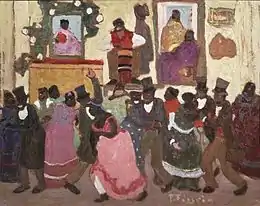 Candombe - کاندومبه (رنگ روغنی روی مقوا) - ۶۸×۵۳ سانتیمتر
Candombe - کاندومبه (رنگ روغنی روی مقوا) - ۶۸×۵۳ سانتیمتر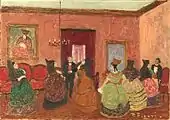 Un pedido a Rosas - درخواستی از روساس (رنگ روغنی روی مقوا) - ۶۹×۴۹ سانتیمتر
Un pedido a Rosas - درخواستی از روساس (رنگ روغنی روی مقوا) - ۶۹×۴۹ سانتیمتر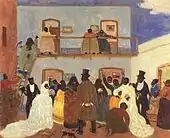 Doble boda - مراسم دوگانهٔ ازدواج (رنگ روغنی روی مقوا) - ۹۸×۷۹ سانتیمتر
Doble boda - مراسم دوگانهٔ ازدواج (رنگ روغنی روی مقوا) - ۹۸×۷۹ سانتیمتر La carreta - گاری (رنگ روغنی روی مقوا) - ۷۰×۴۰ سانتیمتر
La carreta - گاری (رنگ روغنی روی مقوا) - ۷۰×۴۰ سانتیمتر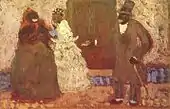 Galantería - زننوازی (رنگ روغنی روی مقوا) - ۲۵٫۵×۱۶٫۵ سانتیمتر
Galantería - زننوازی (رنگ روغنی روی مقوا) - ۲۵٫۵×۱۶٫۵ سانتیمتر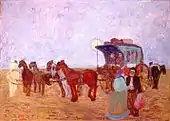 Recogiendo un pasajero - سوار کردن مسافر - (رنگ روغنی روی مقوا)
Recogiendo un pasajero - سوار کردن مسافر - (رنگ روغنی روی مقوا)
فهرست نمایشگاهها
- نقاشی در آمریکای لاتین، ۱۹۸۸، موزهٔ هنر مدرن (نیویورک)
- پدرو فیگاری بلندتر، ۱۹۵۶، سالتو
- نقاشیهای پدرو فیگاری، ۱۹۴۷، موزهٔ هنرهای زیبا (هیوستون)
- نقاشیها و تصاویر چاپی هنرمندان ملل مختلف، ۱۹۴۲، موزهٔ هنرهای زیبا (هیوستون)
- هنرمندان قرن بیستم آمریکای لاتین، ۱۹۹۳، موزهٔ هنر مدرن (نیویورک)
فهرست آثار
- Candombe Bajo La Luna, 1922 (Alfredo Gonzalez Garano Collection)
- Pericon En La Estancia, 1924 (Museo Nacional de Bellas Artes)
- En Familia, 1924 (Andres Garmendia Uranga Collection)
- Pericon, 1925 (Roque Freire Collection)
- Del Entierro, 1928 (Alejandro Shaw Collection)
- Candombe, 1924 (Roque Freire Collection)
- Patio Colonial, 1924 (Raul C. Monsegur Collection)
- El Cielito Bajo El Monte, 1923 (Celina Gonzalez Garano Collection)
- Entierro, 1921 (Museo Nacional de Bellas Artes)
- La Pampa, 1927 (Museo Nacional de Bellas Artes)
منابع
- مشارکتکنندگان ویکیپدیا. «Pedro Figari». در دانشنامهٔ ویکیپدیای انگلیسی، بازبینیشده در ۱۱ نوامبر ۲۰۱۷.
منابع و مطالعهٔ بیشتر
- Baddeley, Oriana, and Valerie Fraser. Drawing the Line: Art and Cultural Identity in Contemporary Latin America. New York: Verso, 1989.
- Basaldua, Emilio. “Hector Basaldua and the Colon Theater: Thirty Years of Stage Design. ” The Journal of Decorative and Propaganda Arts 18 (1992): 32–53.
- Berndtson, Arthur. “Review: La filosofia en el Uruguay en el siglo XX. ” The Americas 13.4 (1957): 424–427.
- Castillo, Jorge. “The Development of a Style. ” XXIII Bienal Internacional de Sao Paolo. ۸ دسامبر ۱۹۹۶ <https://web.archive.org/web/20080203073450/http://www1.uol.com.br/bienal/23bienal/especial/iefi.htm#Nome>.
- Haber, Alicia. “Vernacular Culture in Uruguayan Art: An Análisis of the Documentary Function of the Works of: Pedro Figari, Carlos Gonzalez and Luis Solari. ” Occasional Papers Series 2 (1982).
- Kalenberg, Angel. “Figari, Pedro”. Encyclopedia of Latin American & Caribbean Art. Ed. Jane Turner. 1 vol. New York: New York, 2000.
- Mac Lean, Carlos A. Herrera. Pedro Figari. Buenos Aires: Editorial Poseidon, 1943.
- Manley, Marianne. “Painting and Traditions. ” Art Museum of the Americas. <https://web.archive.org/web/20070609021100/http://www.museum.oas.org/permanent/americanism/figari/writings_about.html#traditions>.
- Sanjurjo, Annick. “Pedro Figari (1861–1938)”. Contemporary Latin American Artists: Exhibitions at the Organization of American States 1941–1964. Ed. Annick Sanjurjo. 1 vol. Maryland: Lanham, 1997.
- Szyszlo, Fernando de. “Contemporary Latin American Painting. A Brief Survey. ” College Art Journal 19 (1959–1960): 134–135.
پیوند به بیرون
- آثار نوشتهشده یا دربارهٔ پدرو فیگاری در بایگانی اینترنت
- پدرو فیگاری در www.pedrofigari.com
- دوسالانه – مهمانان ویژه – پدرو فیگاری در www1.uol.com.br
- پدرو فیگاری در www.museum.oas.org
- MNBA – Museo Nacional de Bellas Artes – آرژانتین در www.mnba.org.ar
- موزهٔ فیگاری، مونتهویدئو – اروگوئه در www.museofigari.gub.uy
This article is issued from Wikipedia. The text is licensed under Creative Commons - Attribution - Sharealike. Additional terms may apply for the media files.